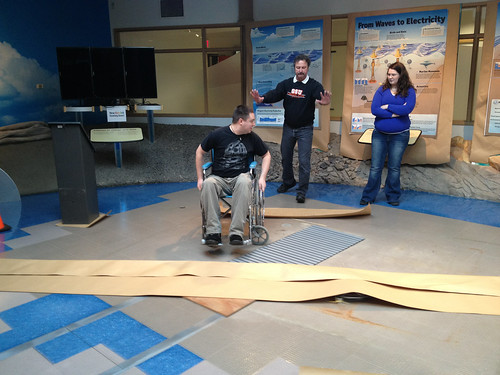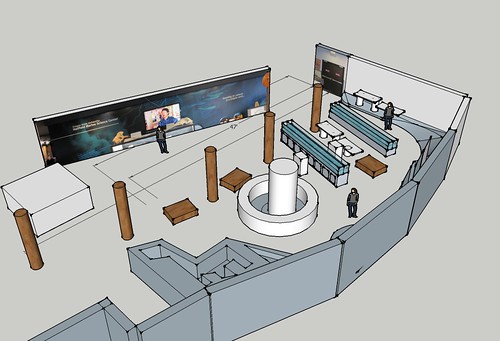Today we met with a consulting engineer to puzzle out the basics of our wave tank. We’ll use the wave tank for two main purposes: modeling tsunami damage and demonstrating wave energy buoys. This means we’ll need to create both breaking waves and swells. This may entail two tanks or a convertible system of some sort.
The wave energy element of the exhibit will use working scale-model wave generators with LED lights to show the output. What better way to demonstrate wave energy than to actually let visitors produce it and see the results? We’ll be able to use this setup to host student design challenges, wherein participants engineer and test their generator arrays for power and efficiency.
We expect visitors (and ourselves) to have a lot of fun with the tsunami modeling aspect of the wave tank. This will feature scale-model buildings and a shore on which waves can break. We’re still exploring the design possibilities. This part of the exhibit will also lend itself to design challenges, as visitors and students will create buildings to test their tsunami resistance.
Tsunami modeling has immediate implications for a town like Newport, which sits right next to an offshore fault. Here at HMSC, we’re at sea level. Regular drills and the presence of emergency supply “bug-out bags” on the walls ensure that everyone here has at least an imagined scenario of what he or she would do in case of a quake. Pat Corcoran is our coastal natural hazards extension agent, and he has lots of info on the subject of “The Big One” and how to prepare.
When the earthquake hit Japan earlier this year, folks on the Oregon coast learned how real this scenario could become. For those of us on the Oregon coast, the local evacuations were a wake-up call. In Japan, the nightmare continues. We imagine great disasters befalling “other people,” but actual disasters tend to remind us that there are no “other people”—only some of “us.” Nobody is immune, and nobody is untouched.
With this unsettling fact in mind, why do we so enjoy the concept of using model waves to smash a miniature coastal town not unlike our own? Back in my own home state of Florida, why do visitors enjoy “Disasterville” at MOSI? Why bring to mind the things that frighten us most? We do so for the same reason we watch horror movies, ride roller coasters or listen to Slayer. That is, as long as we have popcorn to eat, a lap bar to hold us in our seats or a buddy to pull us out of the mosh pit, we can look down upon danger and laugh. We banish the ugly and the frightening to the realm of fiction, if only for a moment. If we learn something useful in the process, all the better.




